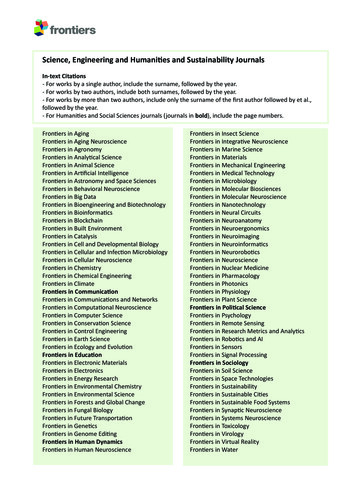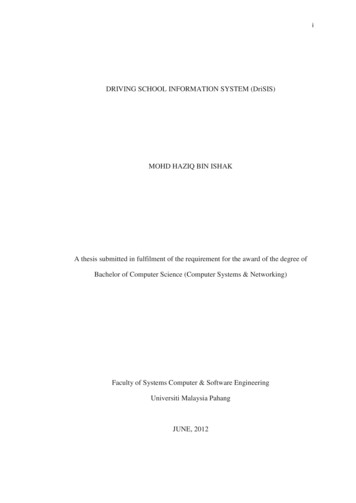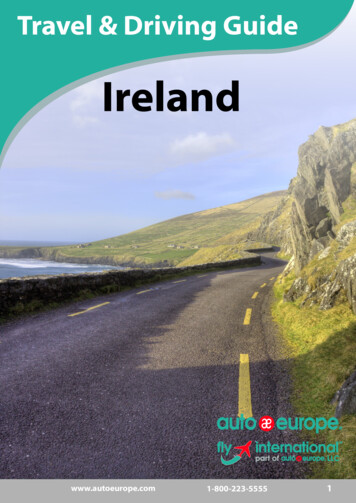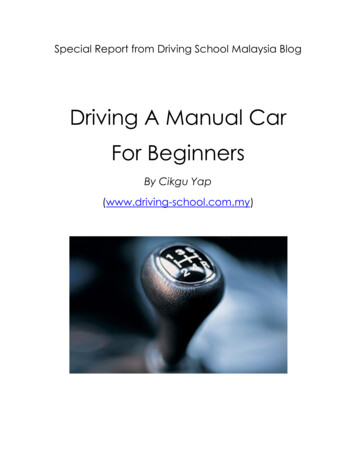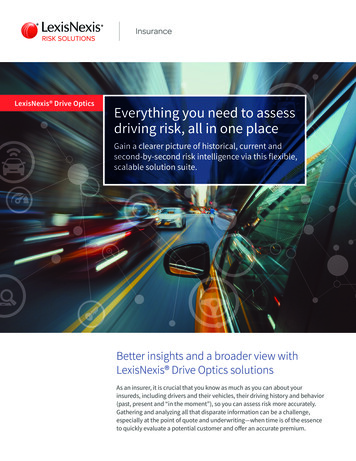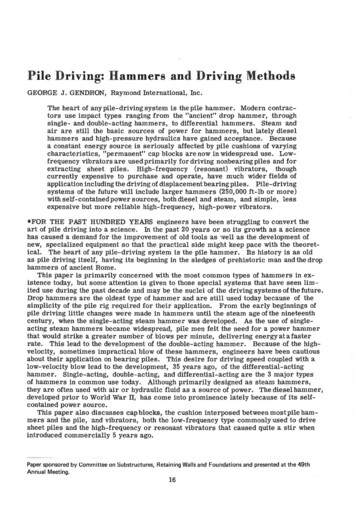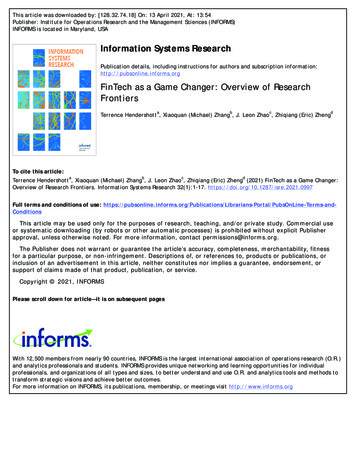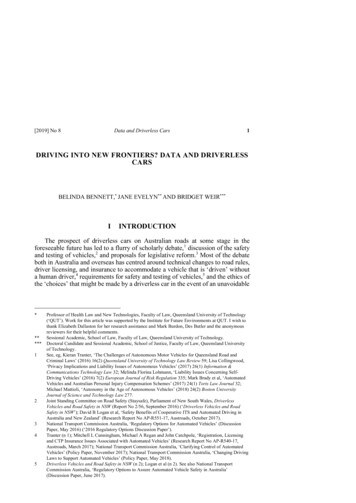
Transcription
[2019] No 8Data and Driverless Cars1DRIVING INTO NEW FRONTIERS? DATA AND DRIVERLESSCARSBELINDA BENNETT,* JANE EVELYN** AND BRIDGET WEIR***IINTRODUCTIONThe prospect of driverless cars on Australian roads at some stage in theforeseeable future has led to a flurry of scholarly debate,1 discussion of the safetyand testing of vehicles,2 and proposals for legislative reform.3 Most of the debateboth in Australia and overseas has centred around technical changes to road rules,driver licensing, and insurance to accommodate a vehicle that is ‘driven’ withouta human driver,4 requirements for safety and testing of vehicles,5 and the ethics ofthe ‘choices’ that might be made by a driverless car in the event of an unavoidable******12345Professor of Health Law and New Technologies, Faculty of Law, Queensland University of Technology(‘QUT’). Work for this article was supported by the Institute for Future Environments at QUT. I wish tothank Elizabeth Dallaston for her research assistance and Mark Burdon, Des Butler and the anonymousreviewers for their helpful comments.Sessional Academic, School of Law, Faculty of Law, Queensland University of Technology.Doctoral Candidate and Sessional Academic, School of Justice, Faculty of Law, Queensland Universityof Technology.See, eg, Kieran Tranter, ‘The Challenges of Autonomous Motor Vehicles for Queensland Road andCriminal Laws’ (2016) 16(2) Queensland University of Technology Law Review 59; Lisa Collingwood,‘Privacy Implications and Liability Issues of Autonomous Vehicles’ (2017) 26(1) Information &Communications Technology Law 32; Melinda Florina Lohmann, ‘Liability Issues Concerning SelfDriving Vehicles’ (2016) 7(2) European Journal of Risk Regulation 335; Mark Brady et al, ‘AutomatedVehicles and Australian Personal Injury Compensation Schemes’ (2017) 24(1) Torts Law Journal 32;Michael Mattioli, ‘Autonomy in the Age of Autonomous Vehicles’ (2018) 24(2) Boston UniversityJournal of Science and Technology Law 277.Joint Standing Committee on Road Safety (Staysafe), Parliament of New South Wales, DriverlessVehicles and Road Safety in NSW (Report No 2/56, September 2016) (‘Driverless Vehicles and RoadSafety in NSW’); David B Logan et al, ‘Safety Benefits of Cooperative ITS and Automated Driving inAustralia and New Zealand’ (Research Report No AP-R551-17, Austroads, October 2017).National Transport Commission Australia, ‘Regulatory Options for Automated Vehicles’ (DiscussionPaper, May 2016) (‘2016 Regulatory Options Discussion Paper’).Tranter (n 1); Mitchell L Cunningham, Michael A Regan and John Catchpole, ‘Registration, Licensingand CTP Insurance Issues Associated with Automated Vehicles’ (Research Report No AP-R540-17,Austroads, March 2017); National Transport Commission Australia, ‘Clarifying Control of AutomatedVehicles’ (Policy Paper, November 2017); National Transport Commission Australia, ‘Changing DrivingLaws to Support Automated Vehicles’ (Policy Paper, May 2018).Driverless Vehicles and Road Safety in NSW (n 2); Logan et al (n 2). See also National TransportCommission Australia, ‘Regulatory Options to Assure Automated Vehicle Safety in Australia’(Discussion Paper, June 2017).
2UNSW Law Journal Forum[2019] No 8crash.6 More recently, there has been a growing debate over the role of data inautomated vehicles and cooperative intelligent transport systems (‘C-ITS’), andthe potential privacy-related concerns that may arise in the context of driverlessvehicles.7This article analyses the legal and ethical issues that are raised by the use ofdata that will potentially be generated by driverless cars, comparing Australianapproaches with those in overseas jurisdictions. Although current vehicletechnology can also generate some data,8 the focus of this article is on the data andprivacy challenges posed by C-ITS and driverless cars. It will argue that the policylandscape for data and driverless cars is characterised by a series of intersections:between transport infrastructure and automated vehicles; between federal andstate/territory privacy laws; and between access to data and privacy. Thecomplexity of these intersections presents significant challenges for thedevelopment of Australian policy and regulation for driverless cars.Part II provides an overview of the different types of data that will be used inthe context of driverless vehicles, including the data that will be generated at aninfrastructure level by connected transport systems, as well as the data that will begenerated by individual driverless vehicles, which may or may not be part of aconnected transport system. Part III analyses the issues that may arise in relationto transport infrastructure data within C-ITS. Part IV evaluates the question ofaccess to data generated by driverless cars, including the question of accessibilityto data by different parties, such as vehicle owners, law enforcement,manufacturers and others. Part V considers the possibility of adopting a ‘privacyby design’ approach to driverless cars before the conclusion in Part VI.II DRILLING FOR THE ‘NEW OIL’With the emergence of ‘smart cities’ which rely on internet connectivity anddata collection and analysis to tailor service delivery,9 the connectivity of the6789Noah J Goodall, ‘From Trolleys to Risk: Models for Ethical Autonomous Driving’ (2017) 107(4)American Journal of Public Health 496; Jan Gogoll and Julian F Müller, ‘Autonomous Cars: In Favor ofa Mandatory Ethics Setting’ (2017) 23(3) Science and Engineering Ethics 681.See, eg, National Transport Commission Australia, ‘Regulating Government Access to C-ITS andAutomated Vehicle Data’ (Discussion Paper, September 2018) (‘2018 Access to Data Discussion Paper’);National Transport Commission Australia, ‘Regulating Government Access to C-ITS and AutomatedVehicle Data’ (Policy Paper, August 2019) (‘2019 Access to Data Policy Paper’); David Vaile, MonikaZalnieriute and Lyria Bennett Moses, The Privacy and Data Protection Regulatory Framework for C-ITSand AV Systems: Report for the National Transport Commission (Report, 2 July 2018); Angela Daly,‘Privacy in Automation: An Appraisal of the Emerging Australian Approach’ (2017) 33(6) ComputerLaw & Security Review 836; Collingwood (n 1); Dorothy J Glancy, ‘Privacy in Autonomous Vehicles’(2012) 52(4) Santa Clara Law Review 1171; Chassel Lee, ‘Grabbing the Wheel Early: Moving Forwardon Cybersecurity and Privacy Protections for Driverless Cars’ (2017) 69(1) Federal CommunicationsLaw Journal 25.‘2018 Access to Data Discussion Paper’ (n 7) 22–3; ‘2019 Access to Data Policy Paper’ (n 7) 25–7.Jesse W Woo, ‘Smart Cities Pose Privacy Risks and Other Problems, but That Doesn’t Mean WeShouldn’t Build Them’ (2017) 85(4) University of Missouri-Kansas City Law Review 953, 955; SofiaRanchordás and Abram Klop, Data-Driven Regulation and Governance in Smart Cities (University of
[2019] No 8Data and Driverless Cars3transport system becomes one element in an integrated approach to urban planning.Smart cities, and the Internet of Things (‘IoT’), of which connected vehicles maybe one example, are built on connectivity and data.10 In a ‘big data’ era, dataincreasingly has a commercial value. Indeed, such is this value that data has beendescribed as ‘the new oil’.11 Yet access to data is becoming a contested space.Increasing connectivity and data collection has been accompanied by concernsabout privacy and surveillance.12 Privacy rights and consumer control of data areemerging as potential brakes on the ubiquity of data access.In the context of transport, there is an emerging debate in Australia andelsewhere about the role of data in C-ITS and automated vehicles (driverless cars).Data is a central issue to these future transportation options.13 With so much datalikely to be generated by driverless cars, the privacy implications of that data, andthe conditions upon which data may be shared and with whom, are emerging asimportant considerations for transportation law and policy.14Glancy argues that there are three privacy interests related to autonomousvehicles: personal autonomy privacy interests, personal information privacyinterests and surveillance privacy interests.15 Personal autonomy interests relate toan individual’s decision about whether to use an autonomous vehicle, and choiceand control in relation to the operation of the vehicle, including where to go andhow to get there.16 The autonomy of the human operator may be delegated to somedegree to the vehicle, with the human user retaining control over the goals of thetransportation.17 While the autonomy interests can be addressed throughaffirmative choice and informed consent, the complex technical nature ofautonomous vehicles can present difficulties in terms of making informationaccessible to consumers so as to enable informed decision-making.18 Autonomyinterests may also be addressed by anonymity of data, although it may be difficultto achieve this within connected transport systems.19 The data generated byautonomous vehicles will also generate personal information privacy interestsaround the collection and use of the data.20 Finally, autonomous vehicles will raise1011121314151617181920Groningen Faculty of Law Research Paper Series No 7/2018, February 2018) https://ssrn.com/abstract 3126221 .Woo (n 9); Ranchordás and Klop (n 9).See, eg, ‘The World’s Most Valuable Resource Is No Longer Oil, but Data’, The Economist (online, 6May 2017) ata ; Susie Gharib, ‘Intel CEO Says Data is the New Oil’, Fortune (online, 7 June 2018) nich-data/ ; ‘Data Is the New Oil’, The Australian(online, 5 May 2017) news-story/f386217a9c63ac5ee6e1473413e9bda ; Perry Rotella, ‘Is Data theNew Oil?’, Forbes (online, 2 April 2012) 02/is-datathe-new-oil/#20d39e57db3d .Woo (n 9); Ranchordás and Klop (n 9).Collingwood (n 1) 35.Ibid; Daly (n 7).Glancy (n 7) 1187–216, discussed in Collingwood (n 1) 35–6.Glancy (n 7) 1188–95.Ibid 1190–1.Ibid 1195.Ibid.Ibid 1195–206.
4UNSW Law Journal Forum[2019] No 8surveillance privacy interests.21 These interests ‘respond to people’s aversion tobeing constantly watched, tracked or monitored as they travel from place toplace’.22Part of the complexity of the debates about data and driverless cars is that theyconnect with our expectations of privacy in our vehicles.23 Furthermore, debateabout the regulatory implications of data, data sharing and privacy for driverlesscars cannot be divorced from the broader debates within society about data andprivacy and consequently are occurring within a rapidly changing social, ethicaland regulatory environment around data and privacy more generally.There are two broad areas in which data will potentially be generated bydriverless cars and connected transport systems. The first relates to C-ITS whichis essentially the road and traffic infrastructure and the ‘smart’ technologies thatwill allow vehicles to communicate with this infrastructure, known as Vehicle-toInfrastructure (‘V2I’) communication.24 It is in this sense that automated vehicleswould also be connected vehicles, thus allowing for communication about matterssuch as traffic congestion.25 However, within C-ITS, vehicles may alsocommunicate with other vehicles (‘V2V’) and with other road users such aspedestrians and cyclists (‘V2X’).26C-ITS have the potential to deliver improvements in road safety throughcollision avoidance and hazard detection, for example, by providing warning ofpotential hazards such as stationary vehicles ahead or approaching emergencyvehicles, or warning of road works or reduced speed limits.27 In addition, C-ITSmay improve safety for vulnerable road users such as pedestrians, motorcyclists orcyclists by providing enhanced detection by motorists of these road users.28Drivers may also be provided with improved signage in their vehicles, providingthem with information on speed zones, stop signs, changed road surfaces, orhazardous weather conditions.29 Emergency response times to crashes could alsobe reduced by automatic emergency post-crash notification systems.30The other area in which data may be generated is by the vehicle itself. Whiledriverless cars are usually also connected vehicles, referred to as ‘connected andautonomous vehicles’ (‘CAVs’), this is not necessarily the case. Driverless carsmay simply allow for automated driving without relying on a connected transport21222324252627282930Ibid 1206.Ibid.Ibid 1216–25; Collingwood (n 1) 38–9.As the NTC notes, ‘C-ITS data is produced when components of the transport network (vehicles, roadsand infrastructure) communicate and share real-time information (for example, information on vehiclemovement, traffic signs and road conditions) through C-ITS devices’: ‘2018 Access to Data DiscussionPaper’ (n 7) 1.Logan et al (n 2) 2.Ibid.Ibid 4.Ibid 7–8.Ibid 8–9.Ibid 9.
[2019] No 8Data and Driverless Cars5system.31 Levels of driving automation for vehicles are generally categorisedaccording to the Society of Automotive Engineers standard SAE J3016 which hassix levels of automation.32 At levels zero, one and two all or part of the drivingtasks are performed by the driver. For example, at level zero the driver performsall of the dynamic driving task, while at level two there is partial drivingautomation. Parking assist functions where the vehicle parks while the driverremains in the car is an example of partial automation.33 Most discussion aboutdriverless cars refers to higher levels of automation. At level three (conditionaldriving automation), a driver may be required to intervene and take over thedriving when requested to do so by the driving system. Heavy vehicle platooningis an example of conditional automation.34 Level four (high driving automation)assumes that the driving task can be undertaken by the driving system even if thedriver does not take over control when requested. An example of high automationwould be an automated vehicle that drives on a pre-determined route, such as ashuttle service,35 while level five (full driving automation) does not require anyintervention by the human ‘driver’.36Some of the data generated by C-ITS or driverless cars will be of a similar kindto that already generated by vehicles. For example, current advanced driverassistance systems already use sensor units to detect obstacles, and electroniccontrol units to provide information on journey distance and to warn of vehiclefaults.37 However developments in C-ITS and automated vehicle technology maygenerate new types of data. In-vehicle video recording, for example, may be usedfor driver recognition for security, or to set driver preferences.38 Thesetechnologies may be extended to the whole of the interior of the vehicle cabin athigher levels of automation where there may be no ‘driver seat’.39 Other data thatmay be generated includes event data recorders to record data about crashes,including whether the driving system or the human driver were in control of thevehicle at the time of the crash, as well as V2V and V2I data.40In its recent discussion paper on data and C-ITS and automated vehicles, theNational Transport Commission (‘NTC’) stated:31323334353637383940‘2018 Access to Data Discussion Paper’ (n 7) 61–2; ‘2019 Access to Data Policy Paper’ (n 7) 48. Seealso Glancy (n 7) 1176 (drawing a distinction between ‘selfcontained autonomous vehicles’ and‘interconnected autonomous vehicles’).‘2016 Regulatory Options Discussion Paper’ (n 3) 31.Ibid 32.Ibid 32: with platooning, ‘except for the lead truck in the platoon, the system takes control of driving andmonitoring the road environment on specific roads, and the driver monitors the automated drivingsystem’.Ibid 33.Ibid.‘2018 Access to Data Discussion Paper’ (n 7) 22; ‘2019 Access to Data Policy Paper’ (n 7) 25.‘2018 Access to Data Discussion Paper’ (n 7) 25; ‘2019 Access to Data Policy Paper’ (n 7) 25.‘2018 Access to Data Discussion Paper’ (n 7) 25–6; ‘2019 Access to Data Policy Paper’ (n 7) 26.‘2018 Access to Data Discussion Paper’ (n 7) 26–8; ‘2019 Access to Data Policy Paper’ (n 7) 26.
6UNSW Law Journal Forum[2019] No 8While only some types of C-ITS and automated vehicle technology (and theinformation generated by it) may raise new privacy challenges, the breadth anddepth of information that will likely be generated may itself present a challenge.41According to the NTC, these privacy challenges are likely to arise for severalreasons: firstly, because automated vehicles will provide all or most of the drivingtask, they will require more inputs to operate than existing driving systems;42secondly, ‘C-ITS and automated vehicle technology will collect (and broadcast) agreater amount of information relating to the safety of vehicle occupants and theroad environment’;43 thirdly, navigation systems and event data recorders willbecome more widespread and their data may be stored for longer periods than iscurrently the case;44 fourthly, ‘external camera input units in automated vehicleswill most likely move from real time feed to recording and storing’;45 and finally,there are greater opportunities for data linkage by governments.46With the value of data gaining increasing recognition, the policy approachesto data management and data sharing are an important element in the policy andregulatory environment for the introduction of C-ITS and driverless cars, as is theapplication of privacy laws. Part III below will analyse the Australian approach tothe use of data in relation to C-ITS, while Part IV will focus on the approaches todata generated by the vehicle itself.III C-ITS DATAGovernments have an interest in being able to access C-ITS data for lawenforcement purposes including crash investigations, for detection of trafficoffences such as speeding, to manage traffic, to manage road safety from naturaldisasters or other hazards, and to assist with strategic planning for infrastructure.47However the connectivity of future transport systems potentially raises complexissues in terms of individual privacy. In its recent discussion paper on ‘RegulatingGovernment Access to C-ITS and Automated Vehicle Data’48 the NTC concludedthat location information generated by C-ITS would most likely constitute‘personal information’ within the terms of the Privacy Act 1988 (Cth) (‘PrivacyAct’).49 ‘Personal information’ is defined in section 6 as:414243444546474849‘2018 Access to Data Discussion Paper’ (n 7) 30. See also ‘2019 Access to Data Policy Paper’ (n 7) 36–8.‘2018 Access to Data Discussion Paper’ (n 7) 30; ‘2019 Access to Data Policy Paper’ (n 7) 39.‘2018 Access to Data Discussion Paper’ (n 7) 30. See also ‘2019 Access to Data Policy Paper’ (n 7) 39.‘2018 Access to Data Discussion Paper’ (n 7) 30; ‘2019 Access to Data Policy Paper’ (n 7) 39.‘2018 Access to Data Discussion Paper’ (n 7) 31. See also ‘2019 Access to Data Policy Paper’ (n 7) 39.‘2018 Access to Data Discussion Paper’ (n 7) 31; ‘2019 Access to Data Policy Paper’ (n 7) 39.‘2018 Access to Data Discussion Paper’ (n 7) 39–40, app C; ‘2019 Access to Data Policy Paper’ (n 7)31–3.‘2018 Access to Data Discussion Paper’ (n 7).Ibid 33–5. See also ‘2019 Access to Data Policy Paper’ (n 7) 42. For discussion of privacy laws seeVaile, Zalnieriute and Bennett Moses (n 7) 11–23.
[2019] No 8Data and Driverless Cars7information or an opinion about an identified individual, or an individual who isreasonably identifiable:(a) whether the information or opinion is true or not; and(b) whether the information or opinion is recorded in a material form or not.Furthermore, location information from C-ITS may reveal ‘sensitiveinformation’ within the definitions of the Privacy Act.50 The definition of ‘sensitiveinformation’ includes information such as a person’s race or ethnic origin, orreligious beliefs, and that is also ‘personal information’ (ie, from which a personis ‘reasonably identifiable’), as well as health information about an individual,‘genetic information about an individual that is not otherwise health information’,‘biometric information that is to be used for the purpose of automated biometricverification or biometric identification’, or biometric templates.51 The NTCconcluded that location information within C-ITS may reveal sensitive informationabout an individual from the venues they visit.52The intersections between C-ITS and privacy laws are made more challengingby the need to also consider the potential application of state and territory privacylaws.53 The lack of harmonisation in Australian privacy laws adds to thecomplexities of the regulatory environment for data-related issues in the contextof driverless cars. As Vaile, Zalnieriute and Bennett Moses have noted:Much of the collection or use of C-ITS & AV data will be done by state and territoryinstrumentalities. The privacy legislation, where it exists, is broadly similar butsome jurisdictions do not have privacy statutes. State and territory differencescreate potential inconsistency, complexity and uncertainty for citizens, regulatorsand industry.54The challenge of determining whether particular forms of data, such as thosegenerated by C-ITS, fall within the definitions of the Privacy Act or state andterritory privacy legislation is significant. Of course, this is not simply a challengefor future transportation systems, but is one arising from the contemporary dataenvironment more generally. As the Productivity Commission noted in its 2017report on data:5051525354‘2018 Access to Data Discussion Paper’ (n 7) 34–6; ‘2019 Access to Data Policy Paper’ (n 7) 42; Vaile,Zalnieriute and Bennett Moses (n 7) 23–6. For discussion of the definitions of ‘personal’ and ‘sensitive’information in Commonwealth, state and territory privacy legislation see Vaile, Zalnieriute and BennettMoses (n 7) app B.Privacy Act 1988 (Cth) s 6. For discussion see ‘2018 Access to Data Discussion Paper’ (n 7) 34; ‘2019Access to Data Policy Paper’ (n 7) 39; Vaile, Zalnieriute and Bennett Moses (n 7) 23–6.‘2018 Access to Data Discussion Paper’ (n 7) 36; ‘2019 Access to Data Policy Paper’ (n 7) 42. See alsoVaile, Zalnieriute and Bennett Moses (n 7) 26.Vaile, Zalnieriute and Bennett Moses (n 7) app B citing Information Privacy Act 2014 (ACT); Privacyand Personal Information Protection Act 1998 (NSW); Information Act 2002 (NT); Information PrivacyAct 2009 (Qld); Department of the Premier and Cabinet, ‘Cabinet Administrative Instruction 1/89, AlsoKnown as the Information Privacy Principles (IPPS) Instruction, and Premier and Cabinet Circular 12, asAmended by Cabinet 6 February 2017’ (Circular No 12, Government of South Australia, 6 February2017); Personal Information Protection Act 2004 (Tas); Privacy and Data Protection Act 2014 (Vic);Freedom of Information Act 1992 (WA).Vaile, Zalnieriute and Bennett Moses (n 7) 68.
8UNSW Law Journal Forum[2019] No 8The boundaries of personal information are constantly shifting in response totechnological advances and new digital products, along with communityexpectations.The legal definition of personal information, contained in the Privacy Act 1988(Cth), has always had an element of uncertainty, and is managed by guidelines.In the face of rapid changes in sources and types of data, outcome-focused datadefinitions remain essential. But practical guidance (that data custodians andusers can rely on) is required on what sorts of data are covered by thedefinitions.55Internationally, the approach to the privacy issues related to automatedvehicles has been mixed. While different approaches to privacy regulation areevident internationally,56 recognition of the need to address privacy concernsassociated with connected and automated vehicles is a common feature. In Canadathe recommendations of a recent Senate Report included:Recommendation 9: The Government of Canada continue to assess the need forprivacy regulations specific to the connected car.Recommendation 10: Transport Canada bring together relevant stakeholders –governments, automakers, and consumers – to develop a connected car framework,with privacy protection as one of its key drivers.57In the United Kingdom, the approach taken by the House of Lords SelectCommittee Report on connected and autonomous vehicles reflects a need tobalance privacy with use of data, noting:It is essential that any data gathered from CAV are used in accordance with dataprotection law. However, the meaning of personal data is unclear in the contextof CAV. It will be important to achieve privacy for individuals and communities,while using data to achieve efficiency and safety of CAV operations. Data relatingto an individual’s CAV in terms of position, speed and performance on the roadcannot be regarded as entirely personal – such data is needed for public benefit if aCAV system is to operate as a whole. Good data governance will therefore beneeded to secure appropriate protection of personal information while safely usingand linking open and non-sensitive data. Distinctions will need to be made betweencommercially sensitive data owned by technology providers and open data.58A 2017 German report on ethics and autonomous vehicles expresslyrecognised the ‘autonomy and data sovereignty of road users’:Permitted business models that avail themselves of the data that are generated byautomated and connected driving and that are significant or insignificant to vehicle55565758Productivity Commission, Data Availability and Use (Inquiry Report No 82, 31 March 2017) 137,finding 3.4.For example, for discussion of the differences between approaches to privacy law in Europe and theUnited States see Vaile, Zalnieriute and Bennett Moses (n 7) 52–66; ‘2018 Access to Data DiscussionPaper’ (n 7) 16–18; ‘2019 Access to Data Policy Paper’ (n 7) 67–9.Standing Senate Committee on Transport and Communications, Senate of Canda, Driving Change:Technology and the Future of the Automated Vehicle (Final Report, January 2018) 58.Science and Technology Select Committee, House of Lords, Connected and Autonomous Vehicles: TheFuture? (House of Lords Paper No 115, Session 2016–17) 43 [169–70].
[2019] No 8Data and Driverless Cars9control come up against their limitations in the autonomy and data sovereignty ofroad users. It is the vehicle keepers and vehicle users who decide whether theirvehicle data that are generated are to be forwarded and used.59In relation to the connectivity of transport infrastructure, the German reportcautioned that ‘[a]utomated and connected driving could result in the totalsurveillance of all road users Autonomous driving would be at the expense ofautonomous everyday action’.60 Drawing on the ‘principles of data minimizationand data avoidance, which are enshrined in European and German law’,61 thereport states that ‘[i]n keeping with the data law principle of privacy by default,vehicles should, upon delivery, already have privacy-friendly factory settings’ toensure that data that is not ‘safety-critical’ is not collected unless the collectionfeatures are activated by the driver.62The approach in the German report is consistent with the ‘privacy by default’approach in current European law. The General Data Protection Regulation(‘GDPR’) requires a ‘privacy by design’ and ‘privacy by default’ approach fortechnologies that collect data.63 Earlier work by the European Commission Article29 Data Protection Working Party (‘Working Party’) concluded that data generatedby C-ITS could be personal data.64 The Working Party recognised the benefits thatcould be delivered by C-ITS but sounded a cautionary note on the privacy risksstating:that the large scale deployment of this new technology, which will entail thecollection and processing of unprecedented amounts of location data of individualsin Europe, poses new challenges to the fundamental rights and to the protection ofpersonal data and privacy both of users and of other individuals that will possiblybe affected.65In 2017 a working group of the European Commission’s C-ITS Platformconcluded that ‘the balance between privacy, data protection and road safetyshould be thoroughly further assessed’.665960616263646566Federal Ministry of Transport and Digital Infrastructure, Ethics Commission: Automated and ConnectedDriving (Report, June 2017) 12 (‘Ethics Commission: Automated and Connected Driving’). Fordiscussion of the German report see Christoph Luetge, ‘The German Ethics Code for Automated andConnected Driving’ (2017) 30(4) Philosophy and Technology 547.Ethics Commission: Automated and Connected Driving (n 59) 24.Ibid.Ibid 25.‘2018 Access to Data Discussion Paper’ (n 7) 16–17; ‘2019 Access to Data Policy Paper’ (n 7) 68; Vaile,Zalnieriute and Bennett Moses (n 7) 56.European Commission Article 29 Data Protection Working Party, ‘Opinion 03/2017 on ProcessingPersonal Data in the Context of Cooperative Intelligent Transport Systems (C-ITS)’ (Working Paper No252, October 2017). For discussion see Vaile, Zalnieriute and Bennett Moses (n 7) 54–5, 115. With theintroduction of the GDPR in Europe in May 2018, the Article 29 Working Party has now been replacedby the European Data Protection Board: ‘Article 29 Working Party’, European Data Protection Board(Web Page) 9-working-party en .European Commission Article 29 Data Protection Working Party (n 64) 8.C-ITS Platform Phase II, Cooperative Intelligent Transport Systems Towards Cooperative, Connectedand Automated Mobility (Final Report Phase II, European Commission, September 2017) 31. Fordiscussion see Vaile, Zalnieriute and Bennett Moses (n 7) 54–5.
10UNSW Law Journal Forum[2019] No 8As is clear from the above, there is recognition of the need to consider theprivacy implications of C-ITS. Internationally, jurisdictions are grappling with thesignificance of privacy laws for C-IT
5 Driverless Vehicles and Road Safety in NSW (n 2); Logan et al (n 2). See also National Transport . automated vehicles and cooperative intelligent transport systems ('C-ITS'), and the potential privacy-related concerns that may arise in the context of driverless . driverless cars are usually also connected vehicles, referred to as .
